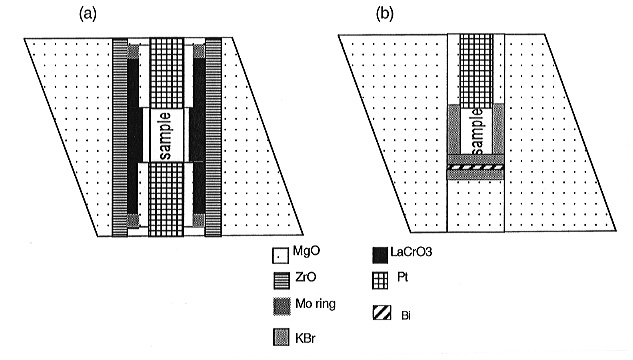

Seismological observations provide the most direct information concerning the physical state of the Earth´s deep interior in the form of wavespeed and density variation as functions of depth. However, seismic profiles alone tell us little of the mineralogical composition and temperature distribution of the mantle. From the types of phases and their proportions established by phase-equilibium experiments, compositional models can be tested using laboratory determined elastic properties of mantle phases.
The measurement of ultrasonic velocities applied in the multi-anvil apparatus provides an in-situ determination of elastic wave speeds through mantle phases at P and T conditions of the Earth´s mantle. The first such measurements of compressional and shear wave velocities in the frequency range 10-30 MHz have been successfully performed on a polycrystalline olivine specimen at 10.5 GPa and 1500° C (see Annual Report 1995). The results can be compared directly with the velocity-depth profile of the mantle.
In spite of these successes, there are several experimental problems
in our early measurements that still need to be addressed. The pressure
dependencies of elastic wave velocities at pressures below 5 GPa are relatively
high compared to literature data. The steep slopes ![]() are possibly the result of the closure of porosity in the polycrystalline
specimens. In the future, we aim to hot press high acoustic quality (e.g.
well-sintered and low porosity) specimens for our ultrasonic measurements.
To do so, the pressure assembly will include a softer material around the
sample, such as a NaCl jacket. The quality of the specimens will then be
examined by both density and bench-top acoustic measurements. Deviatoric
stress in the sample environment for the in-situ ultrasonic measurements
at room temperature can be minimized with a KBr jacket and using only one
Pt buffer rod (Fig. 3.8-1), rather than the two attached to opposite ends
of the sample as before. Of greater concern are the uncertainties in the
velocities obtained by this technique resulting from the uncertainties
in the determination of the sample length at simultaneous high pressures
and temperatures. Simultaneous transverse and longitudinal wave velocity
measurements would resolve this problem but create additional experimental
difficulties. The measured frequency range will also be extended up to
50-60 MHz using 40 MHz transducers for future ultrasonic measurements.
are possibly the result of the closure of porosity in the polycrystalline
specimens. In the future, we aim to hot press high acoustic quality (e.g.
well-sintered and low porosity) specimens for our ultrasonic measurements.
To do so, the pressure assembly will include a softer material around the
sample, such as a NaCl jacket. The quality of the specimens will then be
examined by both density and bench-top acoustic measurements. Deviatoric
stress in the sample environment for the in-situ ultrasonic measurements
at room temperature can be minimized with a KBr jacket and using only one
Pt buffer rod (Fig. 3.8-1), rather than the two attached to opposite ends
of the sample as before. Of greater concern are the uncertainties in the
velocities obtained by this technique resulting from the uncertainties
in the determination of the sample length at simultaneous high pressures
and temperatures. Simultaneous transverse and longitudinal wave velocity
measurements would resolve this problem but create additional experimental
difficulties. The measured frequency range will also be extended up to
50-60 MHz using 40 MHz transducers for future ultrasonic measurements.
 |
|
To date, elasticities of end-member composition mantle phases (e.g. Mg2SiO4 olivine and wadsleyite) have been determined at high pressures. A series of investigations is underway to determine the elastic constants of isostructural analogues (spinels and rocksalt oxides) what contain Fe, to understand the effect of iron content on the pressure and temperature dependencies of elastic properties. The capability of doing in-situ measurements on large volume samples will allow us to determine elasticities of iron-bearing mantle phases (i.e. olivine, wadsleyite, ringwoodite, perovskite and magnesiowüstite) within their respective stability fields. Results from these investigations will allow us to constrain better the composition and temperature distribution of the mantle.

Tel: +49-(0) 921 55 3700 / 3766, Fax: +49-(0) 921 55 3769, E-mail: bayerisches.geoinstitut(at)uni-bayreuth.de
 Previous page
Previous page